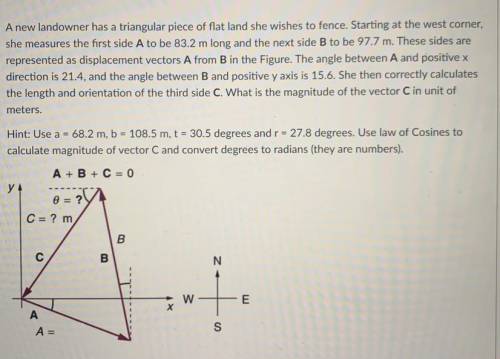
Physics, 29.01.2021 23:20 efraruiz02
“A new landowner has a triangular piece of flat land she wishes to fence. Starting at the west corner,
she measures the first side A to be 83.2 m long and the next side B to be 97.7 m. These sides are
represented as displacement vectors A from B in the Figure. The angle between A and positive x
direction is 21.4, and the angle between B and positive y axis is 15.6. She then correctly calculates
the length and orientation of the third side C. What is the magnitude of the vector C in unit of meters.”
PRETTYY PLEASE HELP i will do anything❤️


Answers: 2
Another question on Physics

Physics, 22.06.2019 16:00
An charge with mass m and charge q is emitted from the origin, (x,y)=(0,0). a large, flat screen is located at x=l. there is a target on the screen at y position y(h), where y(h) > 0. in this problem, you will examine two different ways that the charge might hit the target. ignore gravity in this problem. 1.assume that the charge is emitted with velocity v(0) in the positive x direction. between the origin and the screen, the charge travels through a constant electric field pointing in the positive y direction. what should the magnitude e of the electric field be if the charge is to hit the target on the screen? express your answer in terms of m, q, y(h), v(0), and l. 2.now assume that the charge is emitted with velocity v(0) in the positive y direction. between the origin and the screen, the charge travels through a constant electric field pointing in the positive x direction. what should the magnitude e of the electric field be if the charge is to hit the target on the screen? express your answer in terms of m, q, y(h), v(0), and l.
Answers: 1


Physics, 22.06.2019 19:30
Amass m = 74 kg slides on a frictionless track that has a drop, followed by a loop-the-loop with radius r = 18.4 m and finally a flat straight section at the same height as the center of the loop (18.4 m off the ground). since the mass would not make it around the loop if released from the height of the top of the loop (do you know why? ) it must be released above the top of the loop-the-loop height. (assume the mass never leaves the smooth track at any point on its path.) 1. what is the minimum speed the block must have at the top of the loop to make it around the loop-the-loop without leaving the track? 2. what height above the ground must the mass begin to make it around the loop-the-loop? 3. if the mass has just enough speed to make it around the loop without leaving the track, what will its speed be at the bottom of the loop? 4. if the mass has just enough speed to make it around the loop without leaving the track, what is its speed at the final flat level (18.4 m off the ground)? 5. now a spring with spring constant k = 15600 n/m is used on the final flat surface to stop the mass. how far does the spring compress?
Answers: 3

Physics, 23.06.2019 08:30
Answer on edg: what happens to the light coming from the sun? - scattering what happens to light on the surface of water? - specular reflection what happens to light on the surfaces of rocks? - diffuse reflection
Answers: 3
You know the right answer?
“A new landowner has a triangular piece of flat land she wishes to fence. Starting at the west corne...
Questions




History, 27.03.2020 17:46

World Languages, 27.03.2020 17:46


English, 27.03.2020 17:46


Social Studies, 27.03.2020 17:46





Mathematics, 27.03.2020 17:46




Mathematics, 27.03.2020 17:46


Computers and Technology, 27.03.2020 17:46



